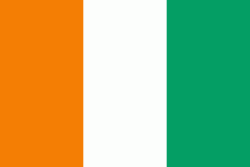Taï National Park (Parc National de Taï)
Taï National Park (Parc National de Taï) is a national park in Côte d'Ivoire that contains one of the last areas of primary rainforest in West Africa. It was inscribed as a World Heritage Site in 1982 due to the diversity of its flora and fauna. Five mammal species of the Taï National Park are on the Red List of Threatened Species: pygmy hippopotamus, olive colobus monkeys, leopards, chimpanzees and Jentink's duiker.
Taï National Park is approximately 100 km from the Ivoirian coast on the border with Liberia between the Cavally and Sassandra Rivers. It covers an area of 3,300 km2 with a 200 km2 buffer zone up to 396 m.
The Taï Forest reserve was created in 1926, and promoted to national park status in 1972. It was recognized as a UNESCO biosphere reserve in 1978, and added to the list of Natural World Heritage Sites in 1982.
The Taï Forest is a natural reservoir of the Ebola virus. The World Health Organization has expressed concern over the proximity of this reservoir to the International Airport at Abidjan.
The park consists of 4,540 km2 of tropical evergreen forest located at the south western corner of Côte d'Ivoire, bordering Liberia. Altitudes vary from 80 m to 396 m (Mt. Niénokoué). The park is situated on a Precambrian granite peneplain of migmatites, biotites and gneiss which slopes down from the gently undulating drier north to more deeply dissected land in the south where the rainfall is heavy. This plateau at between 150–200 meters is broken by several granite inselbergs formed from plutonic intrusions, including the Mont Niénokoué in the southwest. A large zone of varied schists runs north-east to south-west across the park, dissected by tributaries of the main watercourses which run parallel to it: the N'zo, Meno and Little Hana and Hana rivers, all draining southwest to the river Cavally. In the wet season these rivers are wide, but in the dry season become shallow streams. The northern border of the adjoining N'Zo Faunal Reserve is formed by the large reservoir behind the Buyo Dam on the N'zo and Sassandra rivers. There is some swamp forest in the northwest of the park and in N'zo. The soils are ferralitic, generally leached and of low fertility. In the southern valleys there are hydromorphic gley and more fertile alluvial soils (DPN, 1998). Gold and some other minerals exist in small quantities.
Taï National Park is approximately 100 km from the Ivoirian coast on the border with Liberia between the Cavally and Sassandra Rivers. It covers an area of 3,300 km2 with a 200 km2 buffer zone up to 396 m.
The Taï Forest reserve was created in 1926, and promoted to national park status in 1972. It was recognized as a UNESCO biosphere reserve in 1978, and added to the list of Natural World Heritage Sites in 1982.
The Taï Forest is a natural reservoir of the Ebola virus. The World Health Organization has expressed concern over the proximity of this reservoir to the International Airport at Abidjan.
The park consists of 4,540 km2 of tropical evergreen forest located at the south western corner of Côte d'Ivoire, bordering Liberia. Altitudes vary from 80 m to 396 m (Mt. Niénokoué). The park is situated on a Precambrian granite peneplain of migmatites, biotites and gneiss which slopes down from the gently undulating drier north to more deeply dissected land in the south where the rainfall is heavy. This plateau at between 150–200 meters is broken by several granite inselbergs formed from plutonic intrusions, including the Mont Niénokoué in the southwest. A large zone of varied schists runs north-east to south-west across the park, dissected by tributaries of the main watercourses which run parallel to it: the N'zo, Meno and Little Hana and Hana rivers, all draining southwest to the river Cavally. In the wet season these rivers are wide, but in the dry season become shallow streams. The northern border of the adjoining N'Zo Faunal Reserve is formed by the large reservoir behind the Buyo Dam on the N'zo and Sassandra rivers. There is some swamp forest in the northwest of the park and in N'zo. The soils are ferralitic, generally leached and of low fertility. In the southern valleys there are hydromorphic gley and more fertile alluvial soils (DPN, 1998). Gold and some other minerals exist in small quantities.
Map - Taï National Park (Parc National de Taï)
Map
Country - Côte_d'Ivoire
 |
 |
| Flag of Ivory Coast | |
Before its colonization by Europeans, Ivory Coast was home to several states, including Gyaaman, the Kong Empire, and Baoulé. The area became a protectorate of France in 1843 and was consolidated as a French colony in 1893 amid the European Scramble for Africa. It achieved independence in 1960, led by Félix Houphouët-Boigny, who ruled the country until 1993. Relatively stable by regional standards, Ivory Coast established close political-economic ties with its West African neighbours while maintaining close relations with the West, especially France. Its stability was diminished by a coup d'état in 1999, then two civil wars—first between 2002 and 2007 and again during 2010–2011. It adopted a new constitution in 2016.
Currency / Language
| ISO | Currency | Symbol | Significant figures |
|---|---|---|---|
| XOF | West African CFA franc | Fr | 0 |
| ISO | Language |
|---|---|
| FR | French language |















